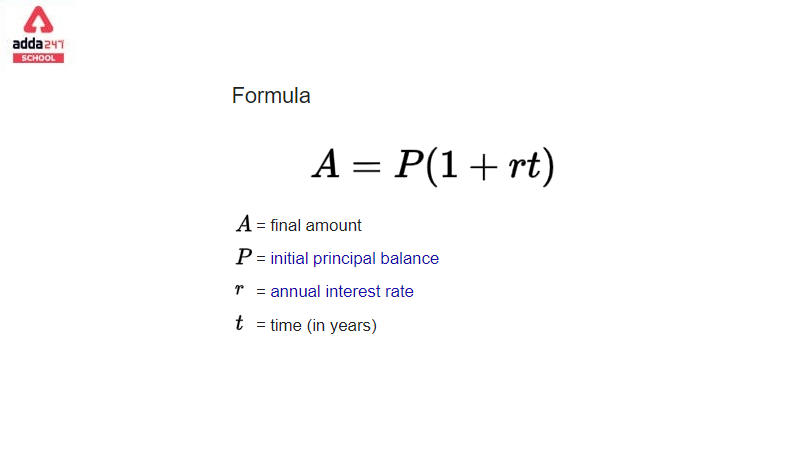Table of Contents
Simple Interest Formula
Simple Interest is a very common term in the banking sector as well as financial operations. Let’s assume we took a certain amount of loan from a bank, After some period of time we have to repay the loan along with some extra amount as per the rate of the bank. Here some extra money that we’ll give to the bank is known as interest. Let’s assume we took a certain amount of loan from a bank, After some period of time we have to repay the loan along with some extra amount as per the rate of the bank. Here some extra money that we’ll give to the bank is known as interest. The interest is two types -Simple and Compound Interest. In this article, we’ll learn about the definition of simple interest, and its formula for solving some problems based on Simple interest. Students must go through the Exercise which is provided at the end of the article.
Simple Interest Formula Definition
Simple interest formula for figuring out how much interest will be charged on a sum of money over a specified time period and at a specified rate. The initial principal amount is always used to compute simple interest. The Interest is calculated according to the rate of the bank in each financial year. For example, I invest in a bank a certain amount of money. Now, Bank will give me a certain sum as interest on my invested money every year according to their interest rate. Before we go into a deep understanding of simple interest, I must understand some essential terminology related to Simple Interest.
Simple Interest Calculator Formula Terminology
Some terms are frequently used while calculating simple interest. These are-
1. Loan- A loan is a sum of money that an individual lends to fulfill needs from a financial institution. There are various types of loans such as Education loans, Car loans, Home loans, Business loans, etc.
2. Principle- In the calculation of simple interest, the Principle is the initial sum of money upon which the interest will be calculated. The principle is represented by ‘P’
3. Rate of Interest – This is one of the most important while calculating simple interest. Rate is the interest rate at which the principal sum is delivered to an individual for a specific period of time. R stands for the interest rate.Rate is always represent in percentage such as – 2% , 15%,etc.
4. Time: Time defines the duration of the time the principal is provided to an individual. T stands for time. Rate is defined by Time. It may be yearly, Half-yearly, Quaterly, etc. For example,
At simple interest,1000 is invested in a scheme for 5 years at a 5% per annum rate.
SI Formula
Amount: Simply Amount define as the total of the initial principal and the interest. The amount is expressed by ‘A’
Amount = Principal + Simple Interest
Someone borrowed 1000/- from a bank for 1 year and the interest is 100/-. So, at end of the specific time period, he has to repay the principal along with the interest which is called the amount.
Simple Interest Formula
Simple Interest is the easiest and quick process to calculate the interest. We use the following formula to calculate Simple interest,
Simple Interest = S.I. = P × R × T
[ In which , P = Principal, R = Rate of Interest in percentage , and T = Time ]
We can always compute the Rate, Amount of Time by following formulas,
Principal-P = S.I / R ×T
Rate of Interest – R= S.I / P × T
Period of Time T = S.I. / P × R
Amount = Principal + Simple Interest
A = P + S.I.
A = P + PRT
A = P(1 + RT)
Let’s understand those formulas by solving Examples
Simple Interest Formula-Based Questions and Answers
Example- 1. A sum of Rs. 800 is lent for one year at a rate of 18% Per annum. Find the Simple interest charged on the sum.
Solution – Principal= P = 800/-
Rate of Interest = R= 18% Per Annum.
Period of time =T = 1year.
As we know the formula to calculate Simple interest,
Simple Interest = S.I. = P × R × T
[ In which , P = Principal, R = Rate of Interest in percentage , and T = Time ]
S.I = 800× 18%× 1 [ P = 800/- ,R= 18% P.A , T = 1year. ]
= 800×( 18÷ 100)×1
= 144 /- ( Answer)
Example-2: A loan of Rs. 4000 is lent for five years at a rate of 15% Per annum from a bank. Find the Amount which is to pay after 5 years to the bank.
Solution – As per the above information,
Principal= P = 4000/-
Rate of Interest = R= 15% Per Annum.
Period of time =T = 5year.
As we know the formula to calculate Simple interest,
Simple Interest = S.I. = P × R × T
[ In which , P = Principal, R = Rate of Interest in percentage , and T = Time ]
S.I = 4000× 15%× 5 [ P = 4000/- ,R= 15% P.A , T = 5year. ]
= 4000×( 15÷ 100)×5
= 3000 ( Answer)
Amount = Principal + Simple Interest
Amount= 4000+ 3000= 7000 ( Answer)
Example-3: What sum of money will produce Rs. 150/- as interest in 6 months at a 4% simple Interest rate per annum?
Solution – Time = T= 6 months = ½ year .
Rate of Interest = R= 4 % Per Annum.
We know that Principal -P = S.I / R ×T
[ In which , P = Principal, R = Rate of Interest in percentage , and T = Time ]
Principal= P = 150 / ( 4 ×½) ×100
P = 150× 100/ 2
P = 150× 50
Principal = 7500 ( Answer )
Simple Interest and Compound Interest: Difference
As learned before that Interest applied to a principle can be two types Simple Interest and compound Interest. Simple interest is a method for figuring out how much interest will be charged on a sum of money over a specified time period and at a specified rate. On the other hand, Compound interest is a type of interest that builds up a loan or deposit and is computed using both the initial principal and the interest that has accrued over periods.
The main differences between Simple and compound interest are pointed below
•Simple Interest is calculated on only the principal for a certain period, But Compound interest is computed using both the initial principal and the interest that has accrued over periods.
•Simple interest calculated by S.I.= P × R × T and Compound interest computed by C.I.= P × (1+r)t – P [ in which , P = Principal, R = Rate of Interest in percentage , and T = Time ]
•On a specific principle, simple interest remains constant year over year. The compound interest varies depending on the length of the time period because it is calculated based on the amount not the principal,
Simple Interest Formula Question Exercise:
1. Find the Amount of Rs 400 for 5 years at a 6 % Per annum simple interest rate.
2. At a 4% Per annum simple interest rate, a certain sum of money amounts to Rs. 560 in 3 years. Find the sum.
3. Find the simple Interest on Rs 500 for 6 years at a 5 % Per annum simple interest rate.
4. A man deposits Rs. 2000 in a bank at 4% Per annum and Rs. 3000 in mutual funds at 14 % Per annum. What is the rate of simple interest on the whole sum?
Simple Interest Formula in Hindi
साधारण ब्याज बैंकिंग क्षेत्र के साथ-साथ वित्तीय कार्यों में एक बहुत ही सामान्य शब्द है। मान लें कि हमने किसी बैंक से एक निश्चित राशि का ऋण लिया है, कुछ समय के बाद हमें बैंक की दर के अनुसार कुछ अतिरिक्त राशि के साथ ऋण चुकाना होगा। यहां कुछ अतिरिक्त पैसा जो हम बैंक को देंगे, उसे ब्याज के रूप में जाना जाता है। मान लें कि हमने किसी बैंक से एक निश्चित राशि का ऋण लिया है, कुछ समय के बाद हमें बैंक की दर के अनुसार कुछ अतिरिक्त राशि के साथ ऋण चुकाना होगा। यहां कुछ अतिरिक्त पैसा जो हम बैंक को देंगे, उसे ब्याज के रूप में जाना जाता है। ब्याज दो प्रकार का होता है-साधारण और चक्रवृद्धि ब्याज। इस लेख में, हम साधारण ब्याज की परिभाषा और साधारण ब्याज पर आधारित कुछ समस्याओं को हल करने के उसके सूत्र के बारे में जानेंगे। छात्रों को उस अभ्यास का अध्ययन करना चाहिए जो लेख के अंत में दिया गया है।
साधारण ब्याज की परिभाषा
साधारण ब्याज यह पता लगाने का एक सूत्र है कि एक निर्दिष्ट समय अवधि में और एक निर्दिष्ट दर पर किसी राशि पर कितना ब्याज लगाया जाएगा। प्रारंभिक मूलधन का उपयोग हमेशा साधारण ब्याज की गणना के लिए किया जाता है। ब्याज की गणना प्रत्येक वित्तीय वर्ष में बैंक की दर के अनुसार की जाती है। उदाहरण के लिए, मैं एक बैंक में एक निश्चित राशि का निवेश करता हूं। अब, बैंक मुझे हर साल मेरे निवेश किए गए पैसे पर उनकी ब्याज दर के अनुसार एक निश्चित राशि ब्याज के रूप में देगा। साधारण ब्याज की गहरी समझ में जाने से पहले, मुझे साधारण ब्याज से संबंधित कुछ आवश्यक शब्दावली को समझना चाहिए।
Read More Post:
- Natural Numbers: Definition And Examples, List, Symbol
- Algebra Formulas PDF For SSC CGL And Class 10
- Trigonometry Table (0 To 360): Formula, Value, Chart, Ratio, PDF For Class 10, 12
- Adjective Definition, Meaning, Types And Examples
- Freedom Fighters Of India Names List
- Computer Shortcut Keys: A To Z List, Chart
Simple Interest Formula: QNA
Q.What do you mean by simple Interest?
Simple interest is a method for figuring out how much interest will be charged on a sum of money over a specified time period and at a specified rate. The initial principal amount is always used to compute simple interest. The Interest is calculated according to the rate of the bank in each financial year.
Q.How to calculate simple interest?
We can calculate simple interest on a certain sum by following the formula,
Simple Interest = S.I. = P × R × T
[ In which , P = Principal, R = Rate of Interest in percentage , and T = Time ]
Q.How to calculate the total amount in the simple interest method?
Amount define as the total of the initial principal and the interest. The amount is expressed by ‘A’
Amount = Principal + Simple Interest
A = P + S.I. [In which , P = Principal, R = Rate of Interest in percentage ,A = Amount, and T = Time ]
A = P + PRT
A = P(1 + RT)
Q.What is the difference between simple and compound Interest?
The main differences between Simple and compound interest are pointed below
•Simple Interest is calculated on only the principal for a certain period, But Compound interest is computed using both the initial principal and the interest that has accrued over periods.
•Simple interest calculated by S.I.= P × R × T and Compound interest computed by C.I.= P × (1+r)t – P [ in which , P = Principal, R = Rate of Interest in percentage , and T = Time ]
•On a specific principle, simple interest remains constant year over year. The compound interest varies depending on the length of the time period because it is calculated based on the amount, not the principal,


 MP Board 10th Result 2024 Out, Get Direc...
MP Board 10th Result 2024 Out, Get Direc...
 MP Board 10th Topper List 2024 Out, Anus...
MP Board 10th Topper List 2024 Out, Anus...
 MP Board 12th Result 2024 Out Today at 4...
MP Board 12th Result 2024 Out Today at 4...














